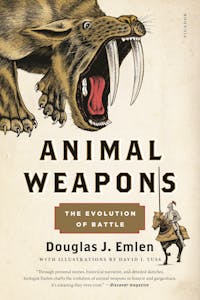Animal Weapons
The Evolution of Battle
 Download image
Download image
ISBN10: 1250075319
ISBN13: 9781250075314
Trade Paperback
288 Pages
$19.99
CA$27.25
Every animal relies on a weapon of some kind—cats have claws, eagles have talons, even the dogs we keep as pets have a respectable set of teeth. In rare cases, we find species whose weapons have become stunningly outsized, some with tusks so massive that those who wield them look like they should collapse under the weight. In Animal Weapons, biologist Douglas Emlen pulls readers into the worlds of these remarkable beasts, trekking through rainforests and mountain passes to unravel the mysteries of their weapons. Along the way, Emlen shows that the essential biology of animal arms races applies to our own weapons, too. A story that begins with biology becomes the story of all weapons, as Emlen seeks to determine where this parallel leaves us today, in a world filled with the deadliest weapons of all time-nuclear, biological, and chemical weapons of mass destruction.
Reviews
Praise for Animal Weapons
“Through personal stories, historical narrative, and detailed sketches, biologist Emlen charts the evolution of animal weapons so bizarre and gargantuan, it's amazing they even exist.”—Discover magazine
“Outstanding . . . Emlen's book on animal warfare reveals a world far more fascinating and intriguing than one we could summon with our imagination.”—The Seattle Times
“A fascinating account of how animal weaponry, both offensive (claws, horns, teeth) and defensive (armor, shelter, thorns, claws again) parallel human weaponry, both offensive (arrows, lances, swords, missiles, A-bombs) and defensive (armor, castles, spies). It's a compelling, fun, often scary analysis. And David Tuss's drawings, especially his animals, made me jealous.”—Robert Krulwich, science correspondent for NPR and cohost of Radiolab
“A great deal of the living world really is red in tooth and claw. That important principle has needed a real biologist to illustrate and explain it, now accomplished dramatically by Emlen.”—Edward O. Wilson, Pulitzer Prize–winning scientist, Harvard University
“Emlen's excellent writing will draw in readers intrigued by astonishingly powerful weapons, both in the wild and in the military, and how they have evolved owing to selective pressures.”—Library Journal (starred review)
“Absorbing . . . Throughout the book, Emlen's demonstrations of the many parallels between human and animal weapons are fascinating, even when the possibilities are frightening . . . Emlen is not a hurried or simplistic storyteller. He is a writer of nuance, and he traveled to many different environments to get the story.”—Kirkus Reviews
“Emlen infuses scientific explanations with entertaining anecdotes from his field research at the University of Montana. Each step of the way, he provides parallels with human weapon development and design, from ancient civilizations to weapons of mass destruction, and the evolutionary process of animals. While his conclusions about the human arms race are dire, it is his description of animal weaponry in action and in evolution that will captivate.”—Publishers Weekly
Reviews from Goodreads
BOOK EXCERPTS
Read an Excerpt
1. Camouflage and Armor
It is November 1969, and dark. Moonlight glints off of tree branches, casting small shadows beside pebbles and twigs on the fresh dirt. A tiny metal door opens and two mice rush out, like gladiators...
MEDIA
Watch
Doug Emlen Interviewed on the SciShow Talk Show
Doug Emlen, author of 'Animal Weapons: The Evolution of Battle' talks about big animal weapons on the SciShow Talk Show.
Share This



